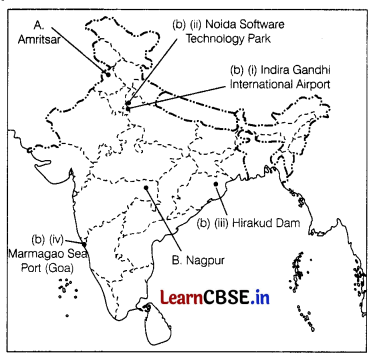Students must start practicing the questions from CBSE Sample Papers for Class 10 Social Science with Solutions Set 7 are designed as per the revised syllabus.
CBSE Sample Papers for Class 10 Social Science Set 7 with Solutions
Time : 3 Hours
Maximum Marks: 80
General Instructions
- Question paper comprises five Sections – A, B, C, D, and E. There are 37 questions in the question paper. All questions are compulsory.
- Section A – From question 1 to 20 are MCQs of 1 mark each.
- Section B – Question no.21 to 24 are Very Short Answer Type Questions, carrying 2 marks each. Answer to each question should not exceed 40 words.
- Section C contains Q.25 to Q. 29 are Short Answer Type Questions, carrying 3 marks each. Answer to each question should not exceed 60 words.
- Section D – Question no. 30 to 33 are long answer-type questions, carrying 5 marks each. Answer to each question should not exceed 120 words.
- Section E – Questions no. from 34 to 36 are case-based questions with three sub-questions and are of 4 marks each.
- Section F – Question no. 37 is map-based, carrying S marks with two parts, 37a from History (2 marks) and 37b from Geography (3 marks).
- There is no overall choice in the question paper. However, an internal choice has been provided in few questions. Only one of the choices in such questions have to be attempted.
- In addition to this, separate instructions are given with each section and question, wherever necessary.
Section A
Section A consists of 20 questions of 1 mark each
Question 1.
Three sisters Yashi, Stuti and It went to watch the movie RRR. The movie RRR was based on two real-life freedom fighters, Ahuri Sitharama Raju and Kumuram Bhecm. As a student of social science, you are familiar with the bravery of Ahuri Sitharama Raju. This freedom fighter was a tribal leader belonging to which state of India?
(a) Odisha
(b) Andhra Pradesh
(c) Tamil Nadu
(d) Maharashtra
Answer:
(b) Andhra Pradesh
Question 2.
This city became the hub of the new print culture, catering to the Western-style schools:
(a) Mumbai
(b) Tokyo
(c) Shanghai
(d) New York
Answer:
(c) Shanghai
Question 3.
The following image represents the Republic of France and became popular in 1850. Identify the given image by choosing the correct option. (1)
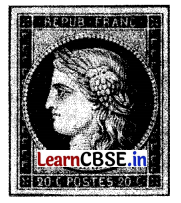
(a) Caricature of Otto van Bismarck
(b) Picture of Germania
(c) Postage Stamp with a picture of Marianne
(d) A poster oí Marianne
Answer:
(c) Postage Stamp with a picture of Marianne
![]()
Question 4.
Arrange the following in chronological order:
I. The International Bank for Reconstruction and Development was set up to finance post-war reconstruction.
II. The Great Depression was caused by a combination of several factors.
III. Rinderpest killed 90% of the cattle in Africa.
IV. The First World War was fought between two power blocs.
Options:
(a) I, III, IV, II
(b) III, IV, II, I
(c) IV, I, II, III
(d) I, II, III, IV
Answer:
(b) III, IV, II, I
Question 5.
Arrange the following in chronological order. (1)
I. Print culture created the conditions for the French Revolution
II. Martin Luther’s writing led to the beginning of the Protestant Reformation
III. Menocchio re-interpreted the message of the Bible
IV. Johannes Gutenberg invented the Printing Press
Codes
(a) IV, III, II, I
(b) I, IV, III, II
(c) I, II, III, IV
(d) IV, II, III, I
Answer:
(d) IV, II, III, I
Question 6.
Which one of the following options best describes the primary sector?
(a) Agriculture
(b) Industry
(c) Banking
(d) Transport
Answer:
(a) Agriculture
Question 7.
Identify the crop with the help of given clues. (1)
These crops are sown in winter from October to December and harvested in summer from April to June. Examples of these crops include wheat, barley, etc.
(a) Rabi crops
(b) Kharil crops
(c) Zaid crops
(d) Cash crops
Answer:
(a) Rabi crops
Question 8.
Which of the following was not one of the initial demands of Sri Lankan Tamils?
(a) Regional autonomy
(b) Recognition of Tamil as an official language
(c) Equal opportunities in securing jobs and education
(d) Creation of an independent Tamil Eelam (state)
Answer:
(d) Creation of an independent Tamil Eelam (state)
![]()
Question 9.
In what sense federations are contrasted with unitary form of government? Identify the correct option.
(a) Powers in the federations arc not concentrated in single hands but distributed among the units.
(b) In a federation, the Central Government can pass orders to the provincial or local Government in an effective manner as
compared to Unitaty Government.
(c) In a federation, State Governments are answerable to the Central Government for every decision.
(d) In a federation, State Government’s wet-s are in the hands of Central Government.
Answer:
(a) Powers in the federations arc not concentrated in single hands but distributed among the units.
Question 10.
………………………………. form of powersharing is most commonly referred to as federalism.
(a) Horizontal division of power
(b) Vertical division of power
(c) Division of power among various communities
(d) Sharing of power among political parties
Answer:
(b) Vertical division of power
Question 11.
Which of the following statements are correct about the tenure of Panchayat? (1)
I. The tenure of Panchayat shall be for five years from the date of its first meeting.
II. The tenure of the Panchayat shall be for five years from the date of the declaration of election results.
III. The tenure of Panchayat shall be for five years from the date of taking oath of office by the elected members.
IV. The tenure of the Panchayat shall be for five years from the date of notification for the conduct of elections to the Panchayat.
Codes
(a) Only I
(b) Both I and II
(c) Both II and III
(d) Only IV
Answer:
(a) Only I
Question 12.
There are two statements marked as Assertion (A) and Reason (R). Mark your answer as per the codes.
Assertion (A): Kerala has low Infant Mortality Rate.
Reason (R): Kerala has adequate provision of basic health and education facilities.
Options:
(a) Both (A) and (R) are true and (R) is the correct explanation of (A).
(b) Both (A) and (R) are true but (R) is not the correct explanation of (A).
(c) (A) is correct, but (R) is wrong.
(d) (A) is wrong, but (R) is correct.
Answer:
(a) Both (A) and (R) are true and R is the correct explanation of (A).
Question 13.
Mr N Khan holds a significant position in the Municipal Corporation Office of Meerut. He presides over the meetings of the Municipal Corporations of his city. To your knowledge, Mr N Khan is a ………………… .(1)
(a) Magistrate
(b) Deputy mayor
(c) Block development officer
(d) Mayor
Answer:
(d) Mayor
Question 14.
Read the given data and find out which state has high HDI.
| State | Infant Mortality Rate per 1000 live births (2016) | Literacy Rate % (2011) |
| Punjab | 21 | 76.68 |
| Kerala | 10 | 93.41 |
| Haryana | 33 | 76.64 |
(a) Haryana
(b) Kerala
(c) Punjab
(d) None of these
Answer:
(b) Kerala
Question 15.
Read the data given in the following table and answer the given question. (1)
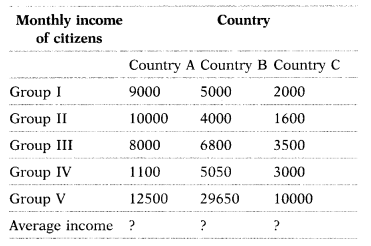
Which country has more equitable distribution of income?
(a) Country A
(b) Country B
(c) Country C
(d) Both Countr A’ and ‘Country B’
Answer:
(a) Country A
![]()
Question 16.
Find the odd one out from the following:
(a) MTNL, Indian Railways, Jet Airways, All India Radio
(b) Cobbler, Washerman, Tailor, Potter
(c) Teacher, Doctor, Tourist guide, Lawyer
(d) Postman, Bank cashier, Soldier and Police constable
Answer:
(a) MTNL, Indian Railways, Jet Airways, All India Radio.
Question 17.
A big land owner named Rahul has purchased farm machinery worth ₹ 10 lakhs to mechanize his farms. 20 small labourers and their families working in his farms arc dissatisfied with this decision. Analyze the information to choose the suitable option from the given options. (1)
(a) Income is an inadequate measure of development.
(b) India has a low HDI ranking.
(c) Development goals differ according to situations.
(d) Total income is more suitable for comparison.
Answer:
(c) Development goals differ according to situations.
Question 18.
Zafra always complains about her weight. She believes that she is overweight. She tries different methods to lose her weight. She used to search on internet about her problem. Her papa and mummy say to her that she is not overweight. One day, they took her to consult doctor. Doctor asked her age. Then she checked her weight and height. She told her about a scientific calculation on nutrition. This is used to know whether a person is undernourished or overweight. Analyse the information given above, considering one of the following correct option:
(a) Human Development Index
(b) Body Mass Index
(c) Life Expectancy
(d) None of these
Answer:
(b) Body Mass Index
Question 19.
Identify the sector with the help of clues given below. (1)
It covers those enterprises where workers are given regular employment. It is generally registered by the government. In this sector, workers get benefits like provident funds, medical leave, etc.
(a) Organised sector
(b) Unorganised sector
(c) Public sector
(d) Private sector
Answer:
(a) Organised sector
Question 20.
Identify the correct statement/s about MGNREGA:
I. It was passed by the Parliament In August 2005.
II. It was implemented in about 725 districts of India.
III. It is also referred to as the ‘Right to Work’.
IV. On an annual basis, it provides guaranteed 150 days of employment to unemployed people in rural areas.
Options:
(a) I & II
(b) I & III
(c) III & IV
(d) I, II & III
Answer:
(b) I & III
![]()
Section B
Section B consists of 4 questions of 2 marks each
Question 21.
Study the map thoroughly and mention any one major dam that is situated in the highlighted Indian state. (2)
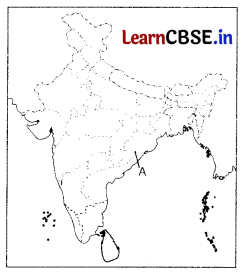
Answer:
The Hirakud dam is on the Mahanadi River. The darn is located in the Sambalpur district of Odisha. The construction of the darn began in 1947 and it was completed in 1957.
Question 22.
Mention any two functions of a Gram Sabha.
OR
Explain the two levels of a federal system.
Answer:
- Gram Sabha elects the members of the Gram Panchayat.
- It supervises the overall working of the Gram Panchayat.
OR
The two levels of a federal system are:
- Firstly, it is the central government that is usually responsible for a few subjects of common national interest.
- Secondly, it is the governments at the state level which are responsible for administering the day-to-day affairs of their respective states.
Question 23.
Write down three types of political party systems.
Answer:
Broadly, the political party system can be divided into the following three categories
- One-Party System In this party system, only one party is allowed to control and run the government.
- Two-Party System In this party system, two parties have a serious chance to win a majority and form a government.
- Multi-Party System In this party system, more than two political parties conduct elections to gain power.
Question 24.
What is money? Why is it called a medium of exchange?
Answer:
Money is something that can act as a medium of exchange in transactions. Before the introduction of coins, a variety of objects was used as money. It is called a medium of exchange because it acts as an intermediate in the exchange process.
Section C
Section C consists of 5 questions of 3 marks each
Question 25.
By giving three examples justify that India has land under a variety of relief features. (3)
Answer:
India has land under a variety of relief features. In India. 30 percent area are mountainous. 27 per cent are plateaus and 43 per cent are plains. al of these have specific advantages to be utilized, Examples of India’s land under a variety of relief features
are
(i) Mountains are source to many streams and rivers some of them are perennial. These regions have very high potential for hydroelectricity production, etc, and are also good tourism destinations.
ii) Plateaus are mostly laden with minerals, fossil fuels and forest, etc so they are economically more viable .
iii) Plains are most important land resource for humans beings . they are fertile and most of the food crops are grown here . they are also useful for the development of factories .
![]()
Question 26.
Explain some economic effects of the Non-Cooperation Movement.
Answer:
In the economic sphere, the effects of the Non-Cooperation Movement are as follows:
- Foreign goods were boycotted and eliminated from the market.
- Liquor shops were picketed and foreign cloths were burnt in large bonfires.
- The import of foreign cloth reduced to half between 1921 and 1922.
- In large number of places, merchants, peasants arid traders refused completely to trade in foreign good or finance foreign trade.
Question 27.
Why the Salt March was an effective symbol of resistance against colonialism? Give reasons. (3)
Answer:
The Salt March was an effective symbol of resistance against colonialism because
- It was the first time that the Indian leaders decided to violate laws. People were now asked not only to refuse cooperation with the British, but also to break colonial laws.
- Thousands of Indians in different parts of the country broke the salt law, manufactured salt and demonstrated in front of government salt factones. due to these developments, the colonial government began arresting the Congress leaders. This led to violent clashes in many places.
True
Question 28.
What are the different goals that people desire for their development?
Answer:
coals that people desire for their development:
- Most people desire for more income. They want regular work, better wages and decent price for their crops or other products that they produce.
- But more income is not the only thing that people desire. They also want to enjoy equal treatment, freedom, security and respect of others. They resent discrimination. All these are important goals.
- In some instances, more income or more consumption becomes less significant than these goals because money can buy material goods only and there are some non-material things important to live.
- Money or material thing is one factor on which our life depends. But non-material things also affect the quality of our life.
Question 29.
State the advantages of local self-government. (3)
Or
Which is the highest tier of the Panchayati Raj? Explain its composition. (1+2)
Answer:
The advantages of local self-government are
- Constitutional status for local self-government has helped to deepen democracy in our country. It has increased women’s representation and voice in our democracy.
- Local people have better knowledge of problems in their localities.
- Local people have better ideas on where to spend money and how to tackle things more efficiently.
- It allows people to participate directly in decision-making.
- The highest tier of the Panchayati Raj System in rural areas is the Zilla Parishad, The Zilla Parishad coordinates the activities of all the Block Samitis in the whole district
The composition of ZiBa Parishad is
(i) All the Panchayat Samitis or MandaIs in a district together constitute the Zilla Parishad.
(ii) Members of the Lok Sabha and MLAs of the district and some other officials of other district-level bodies are also its members,
(iii) The Zilla Parishad Chairperson is the political head of the Zilla Parishad.
![]()
Section D
Section D consists of 4 questions of 5 marks each
Question 30.
Who hosted Vienna Congress in 1815? Analyse the main changes brought by the Vienna Treaty.
OR
Who was Giuseppe Mazzim? Why did his visions frighten the conservatives?
Answer:
In 1815, major European powers-Britain, Russia, Prussia, and Austria who jointly defeated Napoleon, assembled at the Vienna Congress. The Austrian Chancellor, Duke Metternich hosted the Vienna Congress. The representatives concluded the treaty, which brought about the following changes:
- The Bourbon Dynasty that was deposed during the French Revolution was reinstated.
- France lost all the territories it had captured and annexed under the reign of Napoleon.
- An array of states was established on the fringes of France to restrict expansionist policies of France in future.
- Prussia was granted important new territories on its western frontiers. At the other end of the spectrum, Northern Italy was ceded to Austria.
- In the east, Russia was granted a part of Poland, and Prussia was given the portions of Saxony.
- The main intention was to reinstate the monarchies that had been toppled by Napoleon and to create a new conservative order in Europe.
OR
Giuseppe Mazzini was an Italian revolutionary:
- He was born in Genoa in 1807. He became a member of the secret society of the Carbonari. In 1831, at the age of 24, he attempted a revolution in Liguria. For this, he was sent into exile.
- Being underground he founded two more societies namely Young Italy in Marseilles and Young Europe in Berne. Their members included like-minded young men from Poland, France, Italy, and the German states.
- According to Mazzini, God had planned nations to be the natural units of mankind. Thus, Italy could not remain divided in small states and kingdoms. It had to become a single unified republic within a wider alliance of nations. Italian could attain its liberty on the name of its unification only.
- His model was adopted in different countries like Germany, France, Switzerland, and Poland, and secret societies were set up in these countries. Mazzini persistently opposed the monarchy. Conservatives used to be frightened by his vision of democratic republics. This was the reason why. Metternich described him as ‘the most dangerous enemy of our social order.’
Question 31.
Explain the term ‘Conserytism’ with special reference to Europe. (5)
Or
Analyze the measures and practices introduced by the French revolutionaries to create a sense of collective identity amongst
the French people. (5)
Answer:
Conservatism was a political philosophy that stressed the importance of tradition, established institutions and customs, and preferred gradual development to quick change. After the defeat of Napoleon in 1815, European governments were driven by conservatism.
False
They understood that a modem army, an efficient bureaucracy, a dynamic economy. the abolition of feudalism and serfdom could strengthen the autocratic monarchies in Europe. Thus, the conservatives of that time accepted the changes which were in favour of their interests.
Or
Some of the measures and practices introduced by the French revolutionaries to create a sense of collective identify among the French people were as follows
- Union of People The idea of la patrie (the fatherland) and le citoyen (the citizen) emphasized the idea of united people enjoying equal rights under a Constitution.
- New Flag A new French flag, the tricolour, was chosen to replace the former royal standard.
- National Assembly The Estates General was elected by the active citizens and renamed as the National Assembly.
- Patriots Honoured New hymns were composed, oaths taken and martyrs commemorated in the name of the nation.
- Centralised Administration A centralised administrative system was put in place and it formulated uniform laws for all citizens within its territory.
![]()
Question 32.
What is manufacturing? How is the manufacturing industry important for India?
OR
How are manufacturing industry classified based on capital investment, ownership and bulk weight of raw material and finished goods?
Answer:
Manufacturing is the production of goods in large quantities after processing raw materials into more valuable products. The manufacturing sector is considered the backbone of development particularly in general and economic development because:
(i) Manufacturing industries not only help in modernizing agriculture, which forms the backbone of our economy but they also reduce the heavy dependence of people on agricultural income by providing them jobs in secondary and tertiary sectors.
industrial development is a precondition for the eradication of unemployment and poverty from our country . it was also aimed at bringing down regional disparities by establishing industries in tribal and backward areas .
True
(iv) Countries that transform their raw materials into a wide variety of finished goods of higher value are prosperous. India’s prosperity lies in increasing and diversifying its manufacturing industries as quickly as possible.
OR
The manufacturing industry is classified on the basis of capital investment, ownership, and bulk, the weight of raw material and finished goods as follows:
(i) based on capital investment:
- Small-scale industries: These industries come under the maximum investment allowed on the assets of a unit by the government. This investment limit keeps changing over time. At present the maximum investment allowed is rupees one crore.
- Large-scale industries: Industries having investments beyond the number of rupees one crore are considered to be a large-scale industry, for example, the iron and steel industry.
(i) based on ownership: (i) based on ownership: (i) based on ownership: (i) based on ownership: (i) based on ownership: (i) based on ownership: (i) based on ownership: (i) based on ownership: (i) based on ownership: (i) based on ownership: (i) based on ownership: (i) based on ownership: (i) based on ownership: (ii) based on ownership:
- Public sector industries: These industries are owned and operated by government agencies, e.g., BHEL, SAIL, etc.
- Private sector industries: These industries are owned and operated by individuals or a group of individuals, e.g., TISCO, Bajaj Auto Ltd., and Dabur Industries.
- Joint sector industries: These industries are jointly run by the state and individuals or a group of individuals, e.g., Oil India Ltd. (OIL) is jointly owned by the public and private sectors.
- Cooperative sector industries: These industries are owned and operated by the producers or suppliers of raw materials, workers, or both. They collectively arrange resources and share the profits or losses proportionately, e.g., the sugar industry in Maharashtra, and the coir industry in Kerala.
: (iii) Based on the bulk and weight of raw material and finished goods: (iii) Based on the bulk and weight of raw material and finished goods: (iv) Based on the bulk and weight of raw material and finished goods: (iv) Based on the bulk and weight of raw material and finished goods: (iv) Based on the bulk and weight of raw material and finished goods: (iv) Based on the bulk and weight of raw material and finished goods: (iv) Based on the
- Heavy industries: These industries manufacture bulky products, e.g., iron and steel.
- Light industries: These industries use light raw materials and produce light goods, e.g., electrical goods industries.
Section E
Section E consists of 3 Case-based questions of 4 marks each
Question 34.
Read the extract given below and answer the questions that follow:
From the early nineteenth century, there were intense debates around religious issues. Different groups confronted the changes happening within colonial society in different ways and offered a variety of new interpretations of the beliefs of different religions. Some criticized existing practices and campaigned for reform, while others countered the arguments of reformers. These debates were carried out in public and in print. Printed tracts and newspapers not only spread the new ideas, but they shaped the nature of the debate.
A wider public could now participate in these public discussions and express their views. New ideas emerged through these clashes of opinions. This was a time of intense controversies between social and religious reformers and the Hindu orthodoxy over matters like widow immolation, monotheism, Brahmanical priesthood and idolatry. In Bengal, as the debate developed, tracts and newspapers proliferated, circulating a variety of arguments. To reach a wider audience, the ideas were printed in the
every day, spoken language of ordinary people.
Question 34.1
Analyse any one issue of intense debate around religious issues.
Answer:
Different groups confronted the changes happening within colonial society in different ways:
- Some criticized existing practices and campaigned for reform, while others countered the arguments of reformers. These debates were carried out in public and in print.
- Intense controversies between social and religious reformers and the Hindu orthodoxy over matters like widow immolation, monotheism, Brahmanical priesthood, and idolatry.
Question 34.2
Name a newspaper which opposed the Hindu orthodoxy over matters like widow immolation.
Answer:
The Sambad Kaumudi, published by Rammohan Roy, opposed the Hindu orthodoxy over matters like widow immolation.
Question 34.3
Examine the role of print media in these debates.
Answer:
- Printed tracts and newspapers spread the new ideas as well as shaped the nature of the debate.
- They increased public participation in public discussions.
- To reach a wider audience, the ideas were printed in the everyday spoken language of ordinary people.
![]()
Question 35.
Read the given extract and answer the following questions.
Planning is the widely accepted strategy for judicious use of resources. It has importance in a country like India, which has enormous diversity in the availability of resources. There are regions which are rich in certain types of resources but are deficient in some other resources. There are some regions which can be considered self-sufficient in terms of the availability of resources and there are some regions which have acute shortages of some vital resources. For example, the states of Jharkhand, Chhattisgarh, and Madhya Pradesh are rich in minerals and coal deposits. Arunachal Pradesh has an abundance of water resources but lacks infrastructural development.
(i) State how the optimum utilization of resources can be done by planning. (1)
(ii) Evaluate the necessity of planning in India. (2)
(iii) Give two examples of resource availability in India. (1)
Answer:
(i) As planning involves identification and quantification of resources. so the optimum utilization of resources can be done by pia1nng through knowing the exact quantities of resources available and ways can be developed to use them properly.
(ii) Planning is necessary in ¡ndia due to two reasons.
Paraphrase: "They ate": "They ate": "They ate": "They ate": "They ate": "They ate": "They ate": "They ate": "They ate": "They ate": "They ate": "They ate": "They ate": "They ate": "They ate": "They ate": "They ate": "They ate": "They
- There are ‘Atkins which are rich in certain types of resources. but are deficient in some other resources
- Some regions can be considered self-sufficient in terms of the availability of resources, and some regions have acute shortages of some vital resources
India has resource availability which can be seen by the following examples The states of Jharkhand, Chhattisgarh, and Madhya Pradesh are rich in minerals and coal deposits.
Question 36.
Read the given extract and answer the following questions.
Boys and girls are brought up to believe that the main responsibility of women is housework and bringing up children. This is reflected in a Sexual Division of Labour in most families; women do all the work inside the home such as cooking, cleaning, washing clothes, tailoring, looking after children, etc., and men do all the work outside the home. It is not that men cannot do housework; they simply think that it is for women to attend to these things. When these jobs are paid for, men are ready to take up these works, Most tailors or cooks in hotels are men. Similarly, it is not that women do not work outside their home.
False
Question 36.1
“Our society is still a male-dominated patriarchal society”. Give an example to support the statement.
Answer:
In India, the literacy rate among women is only 54% compared to 76% among men. A smaller proportion of female students go for higher education. This is because parents prefer to spend their resources on their boys’ education rather than spending equally on their sons and daughters.
Question 36.2
How does the Indian Constitution ensure equal representation for women?
Answer:
- The Equal Wages Act provides that equal wages should be paid to equal work.
- One-third of seats in local government bodies – in panchayats and municipalities are reserved for women.
![]()
Section F
Section F consists of Map based questions of 5 marks
Question 37.
(a) Two places A and B are marked on the given outline map of India. Identify them and write their correct names on the lines
drawn near them. (2)
A. The place associated with the Jallianwala Bagh incident.
B. The place where the December 1920 session of the Indian National Congress took place.
(b) On the outline map of India, mark and locate any three of the following with suitable symbols. (3)
(i) An airport
(ii) A software technology park
(iii) A dam
(iv) A seaport in Goa
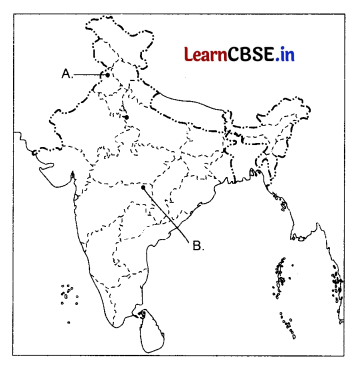
Answer:
